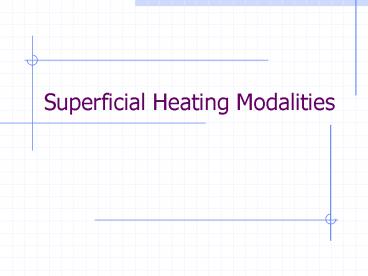Superficial Heating Modalities - PowerPoint PPT Presentation
1 / 19
Title:
Superficial Heating Modalities
Description:
Superficial Heating Modalities. Superficial vs Deep Heating Agents. Superficial ... Depths of penetration 2 cm. Deep. Heat deeper tissues. Depth of penetration 3-5 cm ... – PowerPoint PPT presentation
Number of Views:1676
Avg rating:3.0/5.0
Title: Superficial Heating Modalities
1
Superficial Heating Modalities
2
Superficial vs Deep Heating Agents
- Superficial
- Primarily causes increases in skin temp and
superficial subcutaneous tissue - Depths of penetration lt2 cm
- Deep
- Heat deeper tissues
- Depth of penetration 3-5 cm
3
Biophysical Effects of Superficial Heat
- Magnitude of tissue temperature changes depends
on - The extent of tissue temp rise
- Therapuetic levels 104-113 skin temp
- Above or below?
- The rate energy is added to tissue
- Too fast or too slow
- The volume of tissue exposed
- Larger volume more chances for systemic changes
4
Physiological Responses to Tissue Heating
- Metabolic Reactions
- 2xs metabolic rate 106o F
- Enzymatic activity increases 102o F
- gt122 rapid decrease
- Oxygen uptake?
- Vascular Effects
- Vasodilation
- Importance of Skin BF during Heating
- Local and reflexive mechanisms
5
Physiological Responses to Heating
- Vascular cont.
- Axon Reflex
- Cutaneous receptors
- Some afferents go to SC
- Others go directly to vessel receptors
6
Physiological Responses to Heating
- Vascular cont.
- Local Spinal Reflex
- Activated via cutaneous receptors
- Decreases nerve activity of smooth muscle tissue
- Importance of Skeletal Muscle BF during Heating
7
Physiological Responses to Tissue Heating
- Neuromuscular Effects
- Provides analgesia to assist with pain relief
and muscle guarding - Heat can
- Elevate pain threshold
- Alter nerve conduction velocity
- Change muscle spindle firing rates?
- Temporarily change tension producing
characteristics in muscle
8
Physiological Responses to Tissue Heating
- Connective Tissue Effects
- Superficial heat alone will NOT alter
viscoelastic properties of tissue - Heat and stretch together
- Result plastic elongation of deeper tissue
- Two factors important determining treatment
strategies - Temperature elevation
- Stretch
9
Heating Agents
10
Conductive Heating Agents
- Hot packs
- Superficial moist heat
- Placement considerations
- Depth of Penetration
- Tx time
- Advantages and disadvantages
- Precautions
11
Conductive Heating Agents
- Paraffin Wax Bath Treatment
- Low Melting Point
- Low Specific Heat
- Rationale for Use
- Application Techniques
- Dip and Wrap
- Dip and Immerse
- Tx Time
- Advantage Disadvantages
- Precautions
12
Convective Heating Agents
- Fluidotherapy
- Dry heating agent
- Viscosity low
- Provide high heat fluxes and strong massaging
action - Heat Control
- Fluidotherapy vs Paraffin Wax
- Advantages Disadvantages
13
Radiating Heating Agents
- Infrared Heat Lamps
- Not commonly used
- Very superficial
- 1-10 mm DOP
- Two types
- Luminous
- Non-luminous
- Setup
- Inverse Square Law
- Cosine Law
- Tx Time
14
Clinical Implications for Superficial Heat
- Trunk, shoulder, hip or knee considered mild
heating - Mild vs Vigorous
15
Mild vs Vigorous Heat
16
Surface Temperature Ranges and Subjective Feelings
17
Clinical Implications for Superficial Heat
- Trunk, shoulder, hip or knee considered mild
heating - Mild vs Vigorous
- Pain and Muscle Spasm
- Improving ROM
- Tissue Healing
- Subacute and Chronic Conditions
- Hematoma resolution
- Joint contractures
18
Contraindications to Superficial Heating
- Poor or reduced sensation
- Vascular insufficiency
- Vascular Disease
- Acute injuries
- Malignancy
- Application over where liniments have been applied
19
Heat vs Cold therapy
- Factors to consider
- Stage of healing
- Heat
- Advantages
- Decr pain, incr tissue extensibility, decr
stiffness - Disadvantages
- May incr swelling
- Cold
- Advantages
- Prevent further swelling, decr pain
- Disadvantage
- Incr stiffness, decr tissue extensibility
- Areas of body treated
- Medical status
- Patient preference































